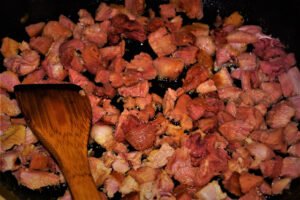By Jim Hingst
Navy bean soup has been standard fare aboard ships of
the United States Navy for at least 100 years. Some believe that this soup
dates back as far as the 19th century. While many who have served in the navy know
this dish as “Navy Bean Soup,” it also goes by the name of “Senate Bean Soup.” Since about 1903 cooks have made this hambone
soup in the U.S. Senate cafeteria.
The standard navy recipe is fairly simple. Originally,
the soup was a mixture of dried beans and salt pork along with some tomatoes
and some simple spices. It often included leftovers from other meals. Today several
variations of the original recipe exist. While my recipe may differ from the chow
cooked according to the Cook Book of the United States Navy, it makes a hearty
warm meal during the cold winter months.
INGREDIENTS
2 tablespoons bacon grease or olive oil for sauteing the onions,
carrots and celery
2 onions, chopped
4 stalks celery, diced
3 large carrots, diced
1 package of frozen spinach
4 cloves of garlic, chopped
1 meaty hambone
3 cups of diced ham or smoked sausage or a combination of the two
2 bay leaves
½ teaspoon dried thyme
½ teaspoon dried marjoram
1 teaspoon dried basil
¼ teaspoon crushed red pepper flakes
1/8 teaspoon cayenne pepper
1 teaspoon turmeric
¼ teaspoon of ground black pepper
½ Tablespoon ground cumin
4 cups dried navy beans or some other white beans, soak
between 8 hours but no more than 12 hours; oversoaking the beans can make them
mushy; drain and rinse
2 14.5 ounce cans diced tomatoes, with juices
96 ounces (3 quarts) chicken broth. You will need enough
broth to cover your hambone.
Salt to taste. Ham is salty, so you may not need any more
to your soup. The best advice is to cook the soup. Near the end of the cooking
process test it for flavoring. Only then add any additional salt. In most cases,
more salt is unnecessary.
DIRECTIONS
Soak the navy beans. Drain and rinse the soaked beans.
Sauté the onions, carrots and celery in olive oil. Cook
until the vegetables are soft and begin to get some color.
Add the garlic, thyme, marjoram, red pepper flakes,
cayenne and black pepper. Continue to sauté until the garlic is fragrant. Add the
vegetables and spices to your stock pot.
You can also sauté the cubed ham and/or smoked sausage. Deglaze the skillet with white wine.
Add the chicken broth, drained beans, diced tomatoes, bay
leaves and hambone. (You can add additional vegetables from your garden or as
you are cleaning out your refrigerator, such as chopped peppers, chopped
potatoes or spinach.) The liquid should
cover the beans by about two inches. Bring the soup to a boil, then reduce to a
simmer. Stir occasionally to prevent burning, which is the only way you could
possibly ruin a soup. (Cooking low and slow releases the flavor from the hambone.)
Cook until the beans are tender. This could take between
2 and 3 hours. Remove the hambone and strip off the ham. The meat should easily
fall off the bone. Return the pieces of ham to the soup.
After cooking the soup for 1½ hours, taste test the soup
before adding any salt or adjusting your seasoning. The salt from the hambone
as well as the saltiness of the chicken broth may provide sufficient salinity.
Remember, if you add too much salt, there’s not much you can do to correct your
mistake.
If you desire, you can thicken the soup with a roux or
cornstarch slurry. Or you can put some of the cooked beans in a blender and puree
them and then return it to the soup.
Remove the bay leaves before serving.
© 2022 Jim Hingst, All Rights Reserved



